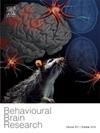雷马唑仑可减轻脂多糖诱发的神经炎症和认知功能障碍
IF 2.6
3区 心理学
Q2 BEHAVIORAL SCIENCES
引用次数: 0
摘要
目的:雷马唑仑是一种新型苯二氮卓类药物,被广泛用作内窥镜手术的麻醉剂;然而,它对认知功能的影响仍不明确,限制了其在全身麻醉中的广泛应用。神经炎症是认知功能障碍(包括阿尔茨海默病、帕金森病、术后谵妄和术后认知功能障碍)的病因和发展过程中一个公认的关键因素。临床前研究表明,雷马唑仑具有抗炎和保护神经的作用,临床报告也显示,接受雷马唑仑治疗的患者术后谵妄的发生率有所降低。然而,雷马唑仑是否能通过其抗炎特性改善认知功能仍不确定。本研究旨在探讨雷马唑仑在脂多糖(LPS)诱导的神经炎症、神经元损伤和认知功能障碍模型中的神经保护作用及其潜在机制 方法:给 C57BL/6J 雄性小鼠腹腔注射 LPS,建立神经炎症诱导的认知功能障碍模型。一部分小鼠在注射 LPS 前 30 分钟腹腔注射雷米马唑仑。小鼠的认知能力通过行为测试进行评估,包括莫里斯水迷宫(MWM)、新物体识别(NOR)测试和开阔地测试(OFT)。海马组织通过血红素-伊红(HE)染色进行分析,以评估结构变化。使用酶联免疫吸附试验(ELISA)和实时定量 PCR 对白细胞介素(IL)-6、IL-1β 和肿瘤坏死因子-α 等炎症标记物进行定量分析。结果:(1)雷米唑仑逆转了LPS诱导的认知缺陷,表现为MWM中空间探索潜伏期缩短、平台穿越增加,以及NOR测试中识别指数升高。(2)雷米唑仑能改善海马形态,减少 LPS 引起的神经元损伤。(3)雷米唑仑能显著降低海马炎症细胞因子水平,抑制小胶质细胞活化,促进M2型小胶质细胞极化,增加TSPO表达:结论:雷米唑仑对 LPS 诱导的认知障碍小鼠模型具有神经保护和抗神经炎症作用。这些作用可能是通过调节 TSPO 来实现的,TSPO 可抑制小胶质细胞活化并促进小胶质细胞从促炎 M1 表型极化到抗炎 M2 表型。本文章由计算机程序翻译,如有差异,请以英文原文为准。
Remimazolam attenuates lipopolysaccharide-induced neuroinflammation and cognitive dysfunction
Objective
Remimazolam, a novel benzodiazepine, is widely used as an anesthetic in endoscopic procedures; however, its effects on cognitive function remain unclear, limiting its broader application in general anaesthesia. Neuroinflammation is a well-established key factor in the etiology and progression of cognitive dysfunction, including conditions such as Alzheimer's disease, Parkinson's disease, postoperative delirium, and postoperative cognitive dysfunction. Preclinical studies have demonstrated that remimazolam exerts anti-inflammatory and neuroprotective effects, and clinical reports indicate a reduced incidence of postoperative delirium in patients treated with remimazolam. Nevertheless, whether remimazolam improves cognitive function through its anti-inflammatory properties remains uncertain. This study aimed to investigate the neuroprotective effects of remimazolam and its underlying mechanism in a lipopolysaccharide (LPS)-induced model of neuroinflammation, neuronal injury, and cognitive dysfunction
Methods
C57BL/6 J male mice were administered LPS intraperitoneally to establish a model of neuroinflammation-induced cognitive impairment. A subset of mice received remimazolam via intraperitoneal injection 30 minutes prior to LPS administration. Cognitive performance was evaluated using behavioural tests, including the Morris Water Maze (MWM), Novel Object Recognition (NOR) test, and Open Field Test (OFT). Hippocampal tissues were analyzed by haematoxylin-eosin (HE) staining to assess structural changes. Inflammatory markers, including Interleukin (IL)-6, IL-1β, and tumor necrosis factor-α, were quantified using enzyme-linked immunosorbent assay (ELISA) and real-time quantitative PCR. Immunofluorescence was used to detect translocator protein (TSPO) and markers of microglia activation (IBA-1, CD16/32, and CD206).
Results
(1) Remimazolam reversed LPS-induced cognitive deficits, as evidenced by shorter spatial exploration latency and increased platform crossings in the MWM, and an elevated recognition index in the NOR test. (2) Remimazolam improved hippocampal morphology, reducing LPS-induced neuronal damage. (3) Remimazolam significantly decreased levels of hippocampal inflammatory cytokines, inhibited microglial activation, promoted M2-type microglia polarization, and increased TSPO expression.
Conclusion
Remimazolam demonstrated neuroprotective and anti-neuroinflammatory effects in a mouse model of LPS-induced cognitive impairment. These effects are likely mediated through the regulation of TSPO, which inhibits microglial activation and promotes the polarization of microglia from the pro-inflammatory M1 phenotype to the anti-inflammatory M2 phenotype.
求助全文
通过发布文献求助,成功后即可免费获取论文全文。
去求助
来源期刊

Behavioural Brain Research
医学-行为科学
CiteScore
5.60
自引率
0.00%
发文量
383
审稿时长
61 days
期刊介绍:
Behavioural Brain Research is an international, interdisciplinary journal dedicated to the publication of articles in the field of behavioural neuroscience, broadly defined. Contributions from the entire range of disciplines that comprise the neurosciences, behavioural sciences or cognitive sciences are appropriate, as long as the goal is to delineate the neural mechanisms underlying behaviour. Thus, studies may range from neurophysiological, neuroanatomical, neurochemical or neuropharmacological analysis of brain-behaviour relations, including the use of molecular genetic or behavioural genetic approaches, to studies that involve the use of brain imaging techniques, to neuroethological studies. Reports of original research, of major methodological advances, or of novel conceptual approaches are all encouraged. The journal will also consider critical reviews on selected topics.
 求助内容:
求助内容: 应助结果提醒方式:
应助结果提醒方式:


